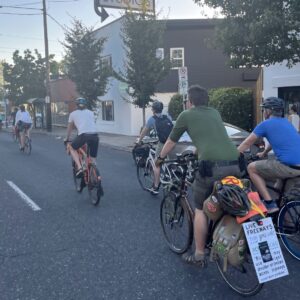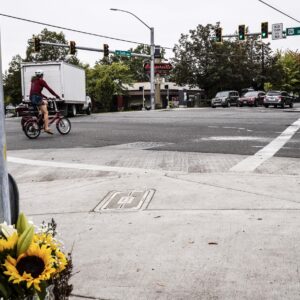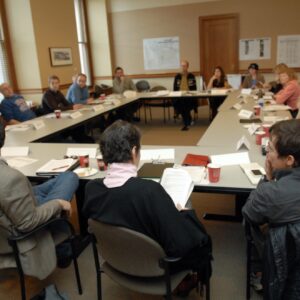
The BTA has just posted their new bicycle boulevard survey. It is important for them to get as much feedback as possible so please consider spending a few minutes to add your input.
The purpose of the survey is to learn more about your riding habits so they can figure out which streets will work best as bicycle boulevards and how they should design them.
The results from this survey will be used when the BTA takes their bicycle boulevard show on the road to a number of neighborhood meetings planned for September.
So what are you waiting for…go take the survey and dream about a future with more bike-friendly streets!






Thanks for reading.
BikePortland has served this community with independent community journalism since 2005. We rely on subscriptions from readers like you to survive. Your financial support is vital in keeping this valuable resource alive and well.
Please subscribe today to strengthen and expand our work.
just took the survey…….
I just took it too : ).
However, I’m confused that it said that curb extensions were to benefit cyclists. I see how they benefit pedestrians and make an area look nicer, but I find that they hinder my cycling. Curb extensions into the part of the road that I ride on, squeezing me into the cars.
Does anyone else have this problem? For those who find curb extensions beneficial: how do they increase your safety?
Sara,
I have been wanting to write more about curb extensions but I misplaced some notes from a meeting a while back…I’ll try to dig them up.
Bottom line is that there are many cyclists that agree with you and curb extensions have become somewhat controversial.
I’ll try and report more on this soon.
I just did the survey. I think the point of the question was to seek opinions on curb extn’s from the viewpoint of pedestrians, cyclists and drivers. Each user is probably going to have a different view. It didn’t necessarily say that curb extn’s were good for cyclists. As a cyclist, I think they are awful, as a pedestrian, I understand why they are supposed to be a benefit, but am not sure the cost is worth that benefit.
For me, the survey was difficult to answer truthfully, because my opinion on routefinding, traffic calming, and other aspects differs greatly depending on whether a particular bike ride is for commuting, errand running, general recreation/fun, or a hardcore training ride.
yeah, i took one look at the picture of curb extensions and checked the “don’t like it one bit” option. narrower streets with cars on them good for bikes? pfah!
Curb extensions have been shown to reduce the speed of auto traffic, certainly making the road just a bit safer. It also means autos can’t swing around that corner with a right turn as fast given the smaller radius, reducing conflicts with sidewalk traffic. I’ve heard from PDOT that they notice cars are more likely to stop for pedestrians and cyclists at curb extensions since they are already so far into the street, but I don’t see that happening much. The biggest benefit is to the pedestrian, and as such, well worth my support. Perhaps there is a middle ground to make cyclists safer: keep the extensions but don’t jut them out so far into the street, allowing room for bikes to pass.
I hate those things! NW Lovejoy is a real treat every morning when the curb extension at the streetcar stops squeezes you between cars and the tire grabbing train tracks. I resort to using the sidewalks at times between 23rd and 17th to avoid the squeeze but that doesn’t make me popular with the pedestrians.
I totally agree with the curb ext frustration. I also had to give the traffic circle bad marks. I ride ne 7th every day, and am bottlenecked at nearly every circle with a car having to suddenly stop behind me.
For traffic circles to really work, they shouldn’t have and lights or stops, just yields, so everybody merges without creating stop and go traffic. Europe is sooo smart!
Geek alert: FYI, “traffic circles” are stop-controlled, and “roundabouts” are yield-controlled. The former has been around here for years (i.e. 39th and Glisan), and the latter is slowly catching on in the States (near Lewis & Clark College). Roundabouts are designed to minimize serious car collisions at intersections, but I suppose they’re good for bikes too.
The traffic circle on SE Ladd at Palm is the biggest trouble spot for me on my daily commute. Every few weeks a motorist tries to squeeze by me at this circle. I equally dislike curb extensions that unnecessarily squeeze bicyclists into the flow of traffic.
These circles and curb extensions essentially force the bicyclist into the role of ‘human speed bump’.
As a cyclist, I think the best form of traffic calming are speed tables, which force the motorists to slow down.
ahhhh, thanks for the clarification!
Though it may provide damning insight into the roots of my inner road manners, I will admit that I learned to ride a bike (and drive a car) in Boston. There, we call these stop-sign-free “roundabouts” “rotaries” and they’re awesome. Stop sign laden “Traffic circles,” on the other hand, are completely baffling. Those should be yield signs!
But that wasn’t the purpose of this comment. I just wanted to cast my vote defending curb extensions. I know they get in our way, but that’s the point. Bikes are traffic and, as such, they should be ridden in the lane of traffic where they don’t get squeezed by curb cuts. Yes, that means pulling into the lane, getting drivers pissed at us, and slowing the whole mess down, but that’s the point and it’s a good thing. Here’s why: the streets with these devices on them aren’t designed solely for the maintenance of a fast and efficient flow of traffic and that’s exactly what curb extensions say, not just to cars, but to bikes as well. I’m not against bikey affirmative action in the form of bike signals, bike boxes, and diversion islands, but curb extensions remind vehicle pilots that we’re all pedestrians and that certain streets belong to people, and not their vehicles. Yay, curb extensions!
(What’s happened to my roots?! In Boston we just drive or bunny hop over those stupid things…)
FIrst off I want to say that I am really hopeful that this survey will give the BTA tons of great data that we will share with you all and the community at large.
A couple personal notes on designs treatments
Curb Extensions – I like them when I am crossing busy streets on my bike and they shorten my crossing distances (like at NE Failing and MLK) but I would prefer a median island and no curb extensions for this purpose. On Alberta, for example I like them b/c they slow car speeds and I take the whole lane. All in all I think median islands are better for bikes and peds.
Traffic Circles – not a huge fan unless they are pretty, with plants and all. I think the ones on 7th are bad for reasons stated above and data backs up these concerns.
Scott
BTA
P.S. Geekers… these are traffic circles, not roundabouts. Roundabouts have very specific design treatments that 7th does not have. See http://roundabout.kittelson.com/
One of the easiest things Portland could do to make neighborhood streets safer for bikes and peds is to make the 30′ before a stop sign “no parking.” Seattle and other cities do this. Especially at intersections of neighborhood streets with busier streets (e.g. Division at SE 46th), it improves sight distance for, and visibility of, all users. On narrow streets, gives a refuge area for bikes and/or cars to wait or pass. Portland’s rule is that vehicles under 6′ height may park there, but it’s rarely enforced. Small blocky cars (Element, PTCruiser, Forester) still block visibility, even though they’re under 6′.
The City admits that curb extensions primarily benefit pedestrians. The bicycling community is divided on their benefit to cyclists: some cyclists believe they are an enhancement, but many cyclists believe they are a potential hazard. Yet the City is now paying for a substantial number of curb extensions with funding earmarked for ‘safety improvements for bicyclists’. I think this is a misplaced use of City funds that could be used to benefit cyclists in other ways, like ramping up the ‘sharrows’ marking program.
To learn even more about traffic-calming options (chokers or neckers, anyone?) take a look at http://www.trafficcalming.org Their list of possible measures (with pictures of each) can occupy a transportation geek for hours.
anything with vegetation that can get tall and/or overgrown can be troublesome for sight lines for both cyclists and cars – you think someone can see you, but because of the big maple, they can’t. I’d love all those options more if they were better maintained or only planted with shorter shrubs. Or better designed for actual stormwater management.